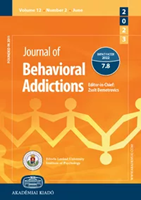The influence of age on gambling problems worldwide: A systematic review and meta-analysis of risk among younger, middle-aged, and older adults
The influence of age on gambling problems worldwide: A systematic review and meta-analysis of risk among younger, middle-aged, and older adults
Author(s): GEORGIA DELLOS, Matthew BrowneSubject(s): Individual Psychology, Neuropsychology, Clinical psychology, Behaviorism, Substance abuse and addiction
Published by: Akadémiai Kiadó
Keywords: problem gambling; pathological gambling; gambling disorder; gambling addiction; prevalence;
Summary/Abstract: Background and Aims: Problem gambling (PG) represents a significant public health concern with widespread effects in various cultures and regions globally, with younger individuals and males at a particularly higher risk. This disparity is attributed to a mix of cultural, developmental, and biological influences. To date, there has not been a comprehensive examination to determine whether this risk pattern holds consistently across different jurisdictions. Methods: We performed a systematic review and meta-analysis using the PRISMA framework, identifying 21 eligible studies from 18 countries, encompassing 156,249 participants (47.6% male and 52.4% female). Results: The studies varied considerably by region (Asia: 19%, Europe: 52%, Oceania: 19%, North America: 10%), the diagnostic criteria for PG, and participation rates in gambling (ranging from 12% to 92%). Data on PG prevalence was categorised by gender and three age groups (young: 18–35, middle: 30–55, and older: 45–65). Using a random-effects meta-analysis, we found a global PG prevalence of 1.9%. Europe reported a significantly lower prevalence (1.3%) compared to North America (5.3%). Men were found to be 3.4 times more likely than women to engage in problem gambling, although the gap narrows in North America. The young demographic showed a 1.51 times higher likelihood of reporting PG compared to the middle-aged group, whereas older adults were 0.80 times less likely to report PG. Notably, age-related effects varied significantly across regions. Conclusions: Our findings confirm that age and gender significantly influence PG risk across cultures, with significant heterogeneity observed across jurisdictions.
Journal: Journal of Behavioral Addictions
- Issue Year: 13/2024
- Issue No: 3
- Page Range: 702-715
- Page Count: 14
- Language: English

